by | Jul 21, 2014 | Blog
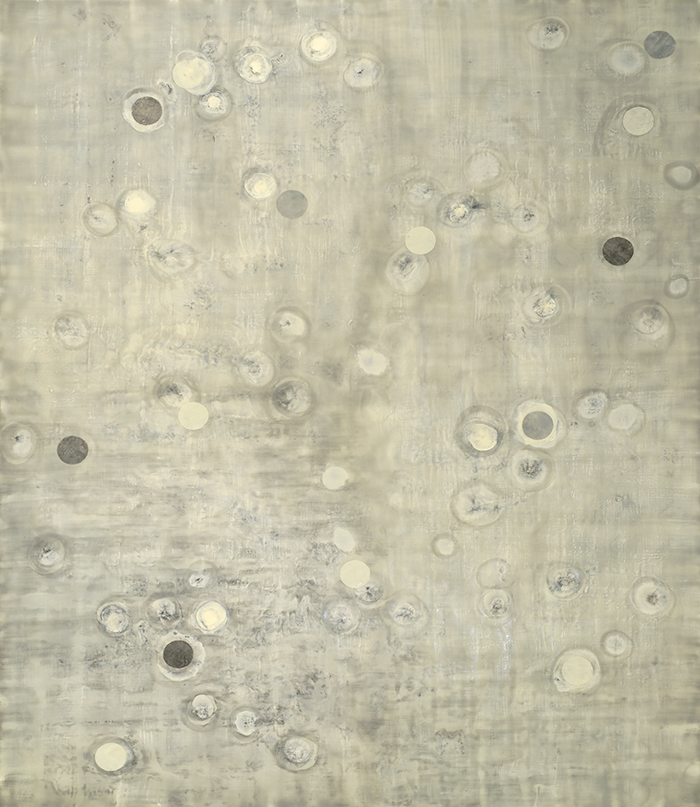
(r)evolution 12, encaustic, collage and oil on panel, 60×48, 2014
Written by Karen Crews Hendon, Curator
Tracey Adams’ new (r)evolution series is a collection of encaustic on panel works created from 2013-2014. Composed of organic shapes arranged on a linear matrix, Adams explores the intersection of pattern, color, and space.
With distinct rhythm, circular shapes in soft to bold hues appear in succession. Like colorful tabs that fade in and out, they create systematic yet gestural patterns.
Color inspires the mood of these compositions, like subtle timbres or overtones in music. The movement and energy felt in the work pulsate, depending on the unpredictable, yet calculated, intervals between them.
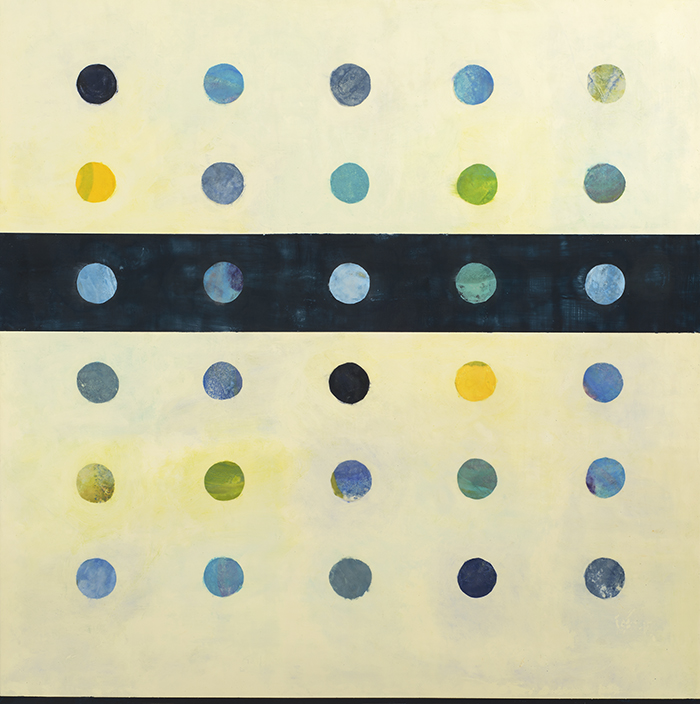
(r)evolution 4, encaustic, collage, and oil on panel, 36×36, 2014
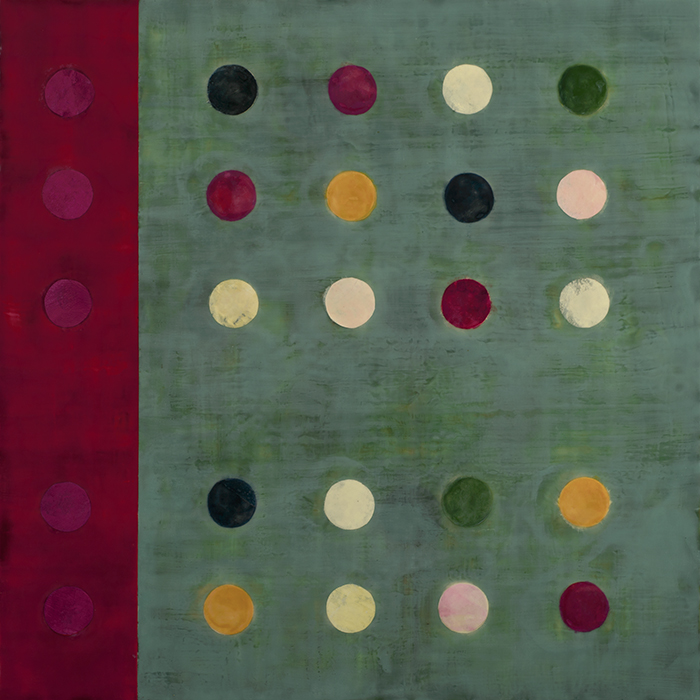
(r)evolution 9, encaustic, collage, and oil on panel, 30×30, 2014
Adams’ passion for music composition, visual perception, and elements found in nature forms a theme at the core of her work. Begun in 2013, (r)evolution, implies a grander variation in which she has opened up and allowed herself a free-flowing perspective.
The artist has named some of her recent paintings Benthic Revolution, 1-8, tapping into the ocean as her primary muse. Her reference to the benthic zone, the lowest level or bottom layer of the ocean, positions the viewer first at the surface.

Benthic Revolution 2, encaustic and collage on Mitsumata, 40×26, 2014
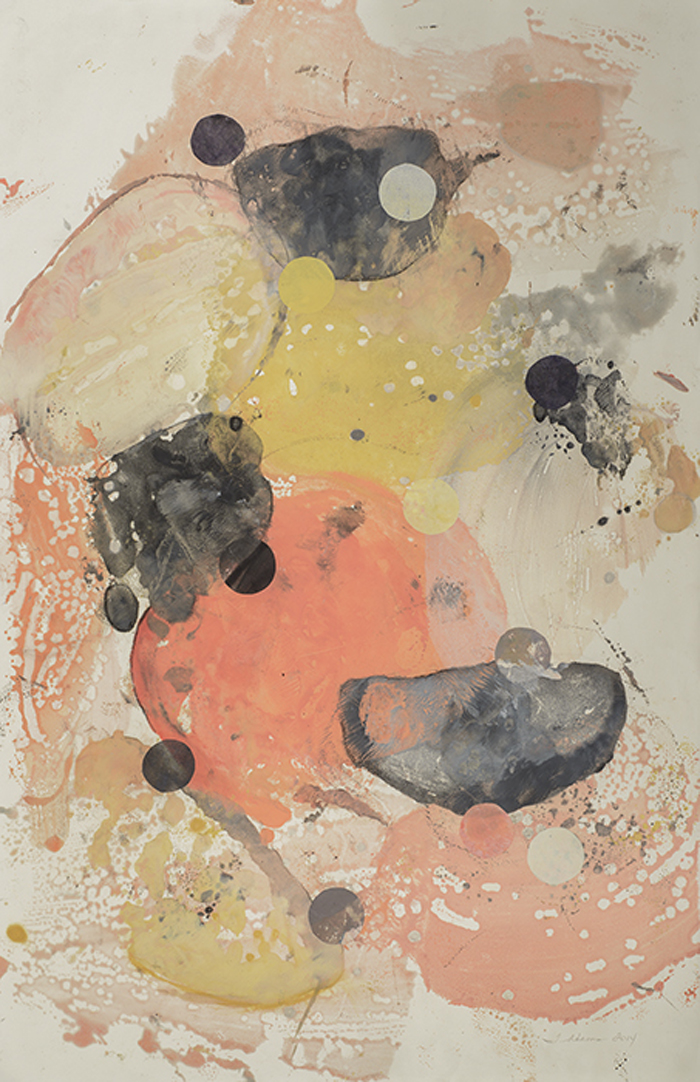
Benthic Revolution 3, encaustic and collage on Mitsumata, 40×26, 2014
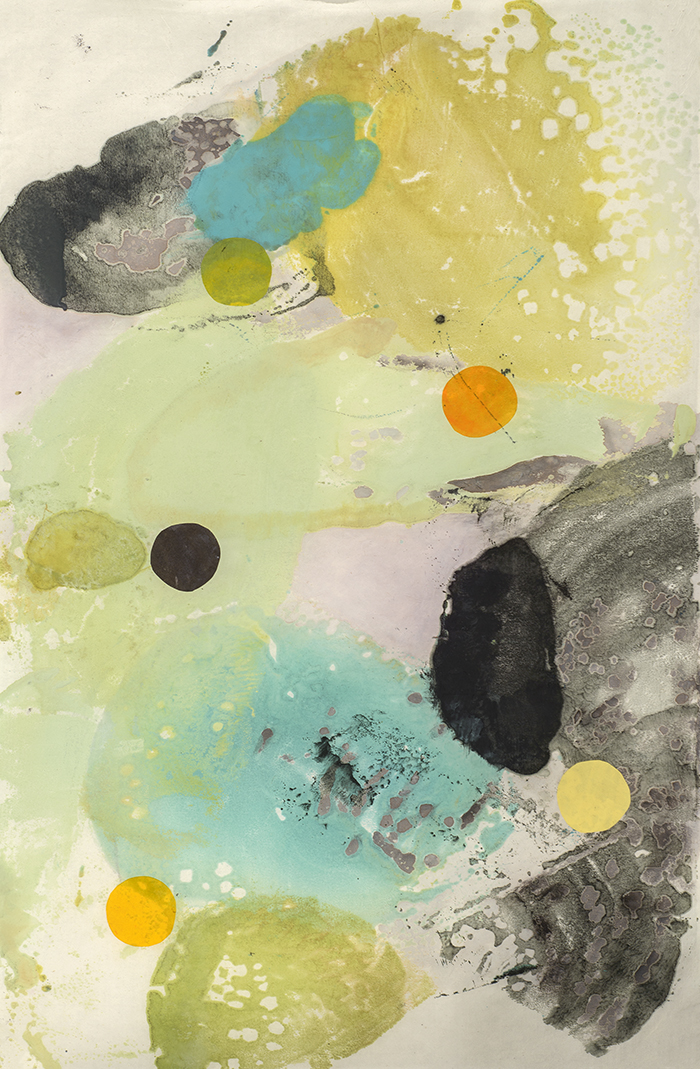
Benthic Revolution 8, encaustic and collage on Mitsumata, 32×21
Like peering into the ocean, a continuum of endless patterns, the chance of seeing the same image repeated is unlikely. Her work reveals the subtleties of many layers and dimensions that emerge and take shape, simulating the currents and color pools in nature.
For the past decade, Adams has integrated encaustic, oil, acrylic, graphite, ink, and collage, pushing the boundaries of these materials. In (r)evolution, Adams selected only pigmented beeswax and collage as her medium. This has allowed her to retain the purity she seeks while pursuing new variations.
The evolution of Tracey Adams’ work is cathartic. Comparable to the music of experimental composer John Cage, she is “purposefully playing” which is “an affirmation of life – not an attempt to bring order out of chaos nor to suggest improvements in creation, but simply a way of waking up to the very life we’re living.”
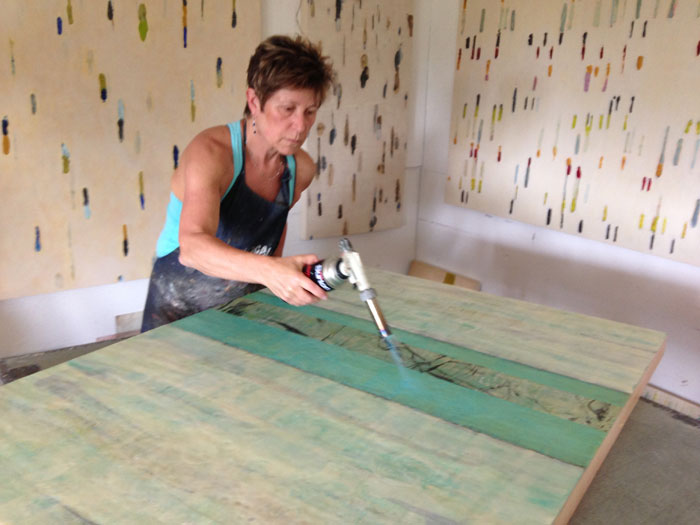
Tracey Adams in her studio
SOLO EXHIBITIONS
Pattern of Infinity
Winfield Gallery, Carmel, CA
July 15 – August 3
Bryant Street Gallery, Palo Alto, CA
July 15 – August 30
Music@Menlo Chamber Music Festival, Atherton, CA
July 18 – August 9
Download Catalogue
Tracey Adams: Patterns of Infinity
GROUP EXHIBITIONS
Outside/Inside
K. Imperial Fine Art, San Francisco, CA
July 15 – August 30
The Circle Game
Tucson Museum of Art, Tucson, AZ
February 22 – September 7
Swept Away
Hunterdon Art Museum, Clinton, NJ
May 18 – September 7
SHIFT: Five Decades of Contemporary California Painting
Monterey Museum of Art, Monterey CA
May 1 – September 22
ARTIST TALKS
Music@Menlo
Artist Talk with Cathy Kimball, Executive Director, San Jose Institute of Contemporary Art
July 29
SHIFT: Five Decades of Contemporary California Painting
Artist Talk with Karen Crews Hendon, Chief Curator, Monterey Museum of Art
August 7
by | Jun 21, 2014 | Blog
My earliest childhood memories are of Helen Ishi, my father’s business partner. Japanese culture is about sharing and generosity with others. When Helen would visit, she would bring little things for me to play with: small Japanese dolls and toys and my favorite, origami. I loved the bright colors and papers that could be folded and fashioned into animals and other shapes. I’ve always loved the texture and look of paper, especially Japanese paper. I think that’s why I studied printmaking in high school and college – initially woodcuts, then drypoint and soft ground etching, and now encaustic monotype. During the last 7 years my focus has been on the encaustic monotype and the variety of ways I can use it in my work: collage, mounted on panels and painted with acrylic or encaustic paint. Now, I fold them into shapes, sometimes trimming to reshape. Folding alters the painted imagery and yields something quite different from the original image. Lately, my favorite time of the day has been when I make the day’s folded piece.
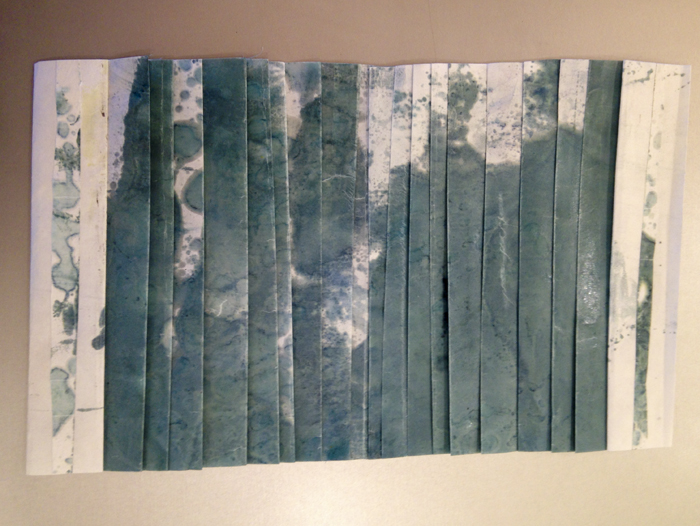
My new series, Folded, is a way of representing time spent in the studio every day through the use of folds. Each piece contains a certain number of folds that correspond to the day of the month. For example, the piece made on June 14 has 14 folds. The folds have different widths, corresponding to a predetermined calculation I make for each piece. The papers used in these pieces are fragments of encaustic monotypes created previously on Japanese papers; the monotypes were made relatively close to the same time as the day the folded piece was made.
This project developed as my other collage projects have – out of a need to break away from whatever painting or show I was working on; the goal being to loosen up and have some fun in a less important and time-consuming way. I set certain parameters for myself: maximum time spent on each folded piece would be an hour or less and no piece would be larger than 12″x12″. Many of the pieces made duirng this first month, June, are smaller. Collage has always been my default for those frustrating and trying moments in the studio and in my life. It contains the perfect balance of intention and chance.
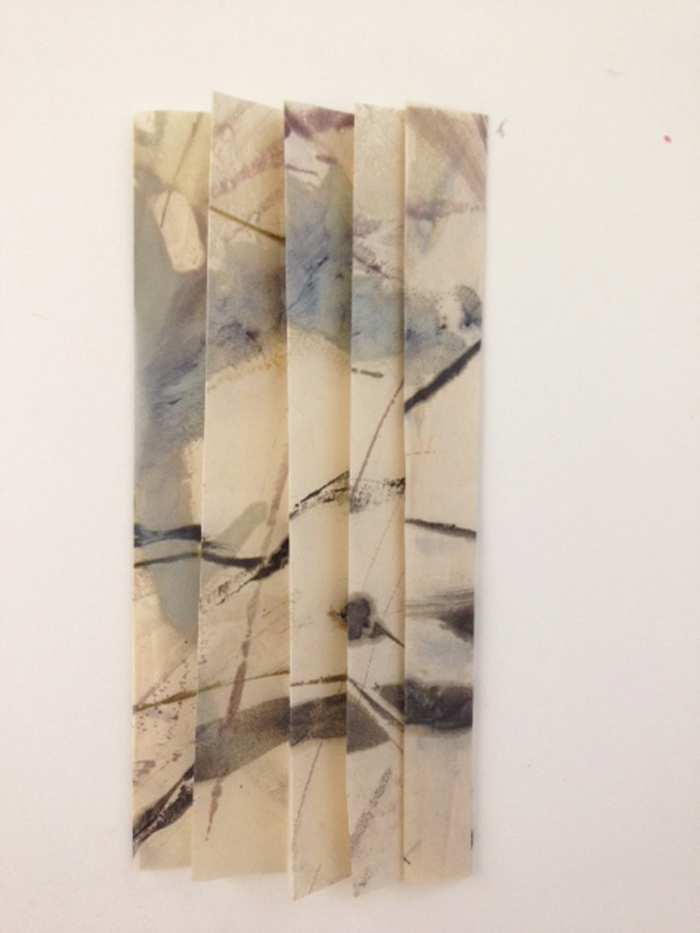
June 5, 2014
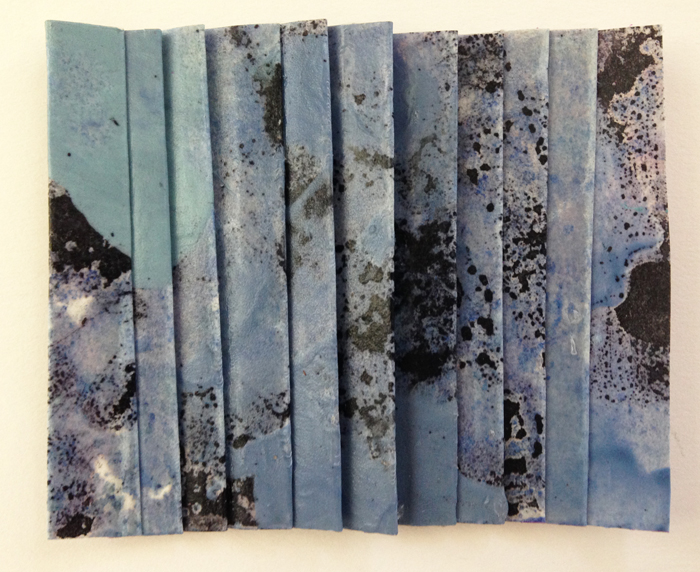
June 10, 2014
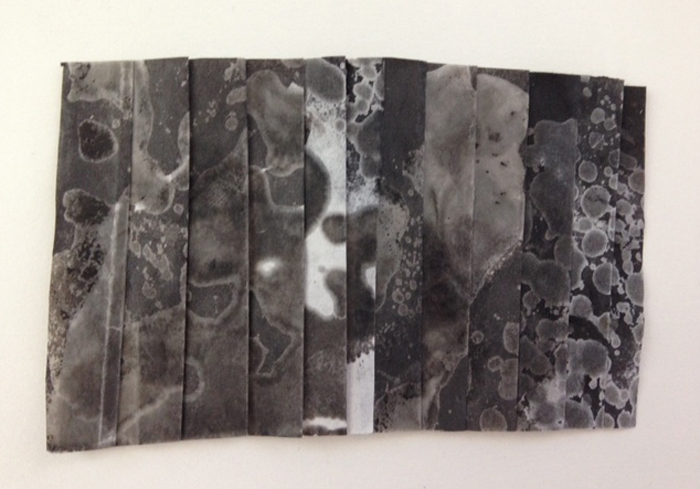
June 12, 2014
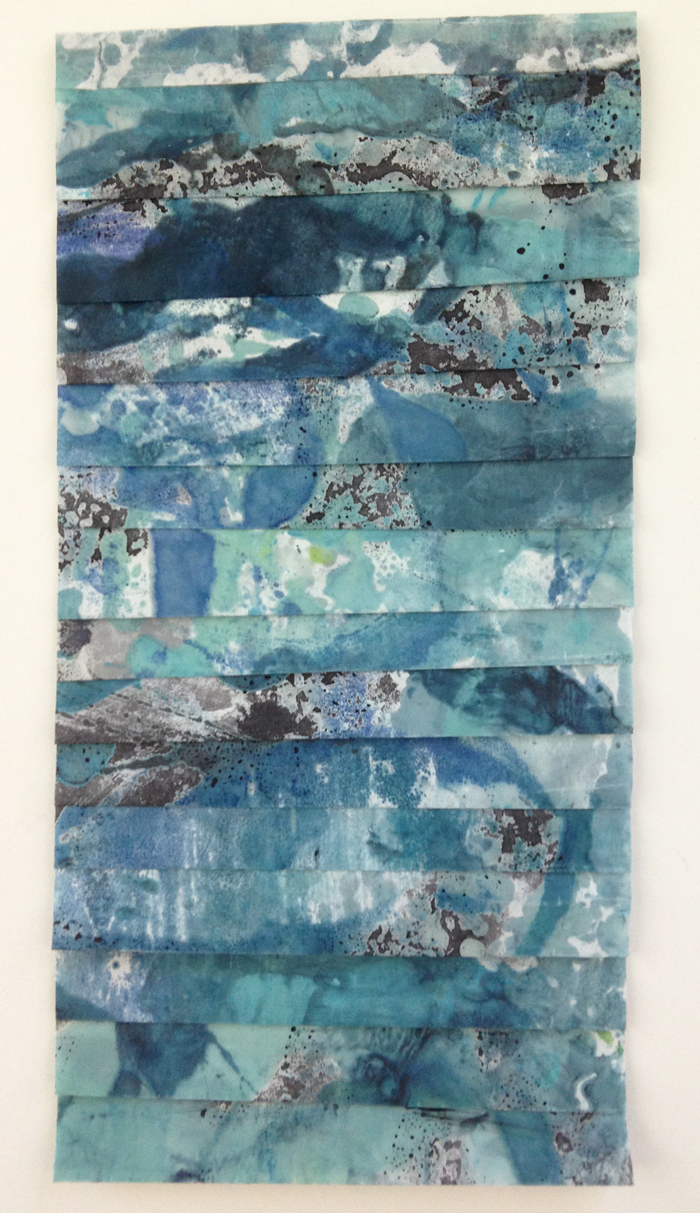
June 14, 2014
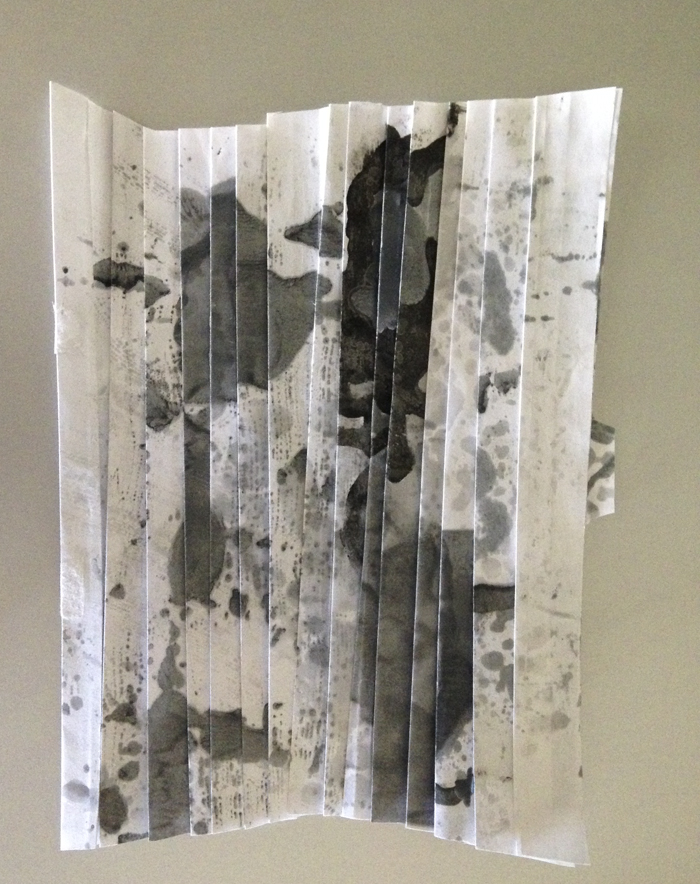
June 15, 2014
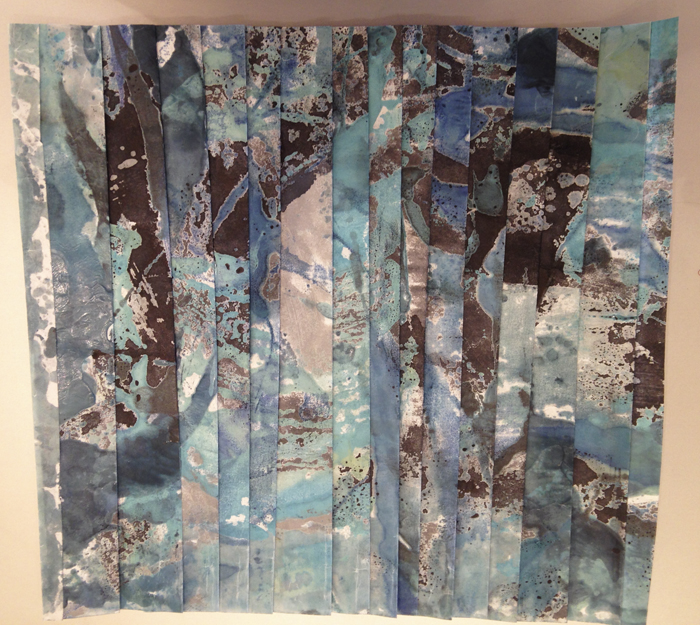
June 16, 2014
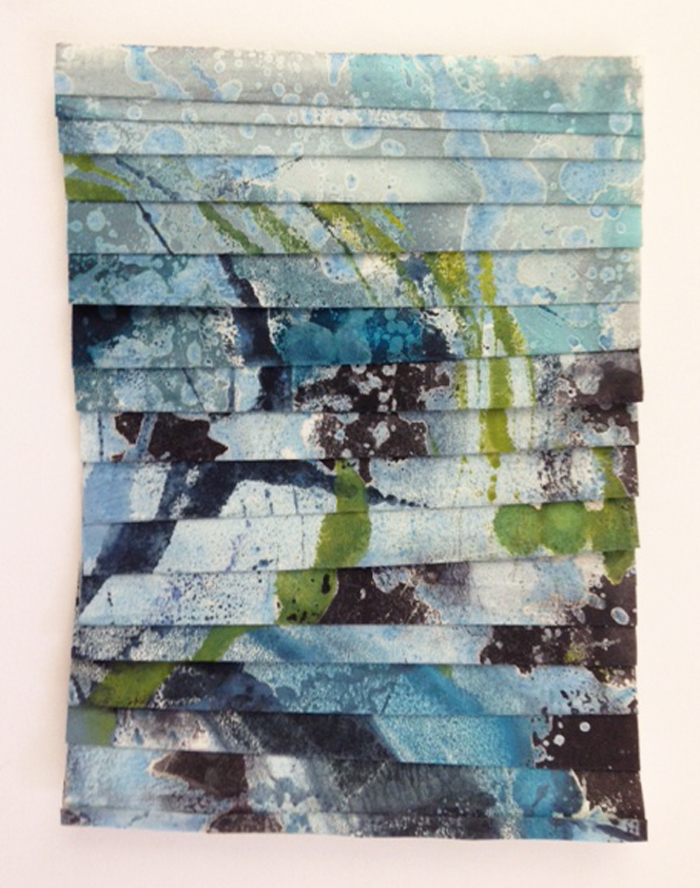
June 17, 2014
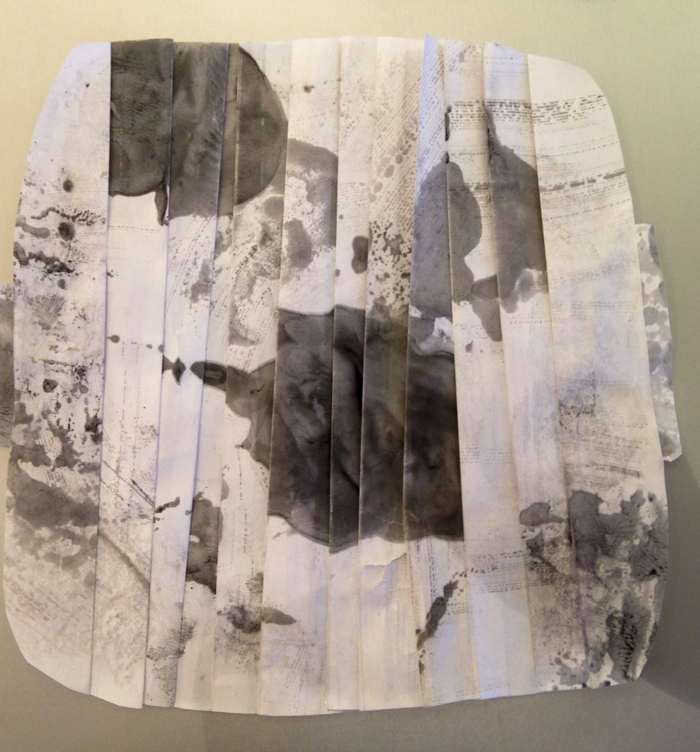
June 11, 2014
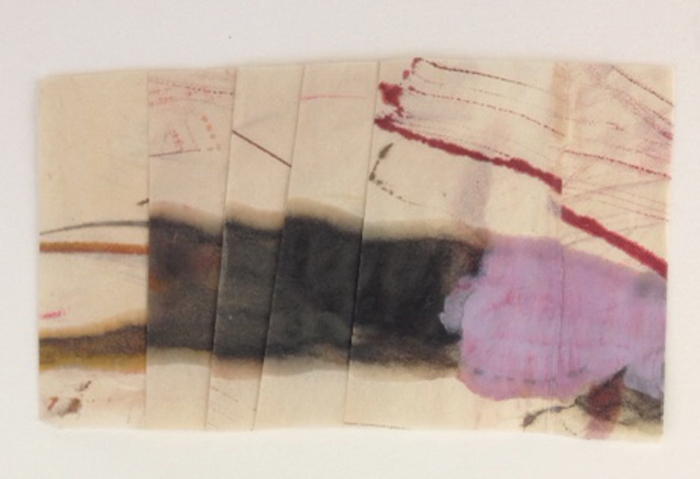
June 6, 2014
by Tracey Adams | Apr 18, 2014 | Blog
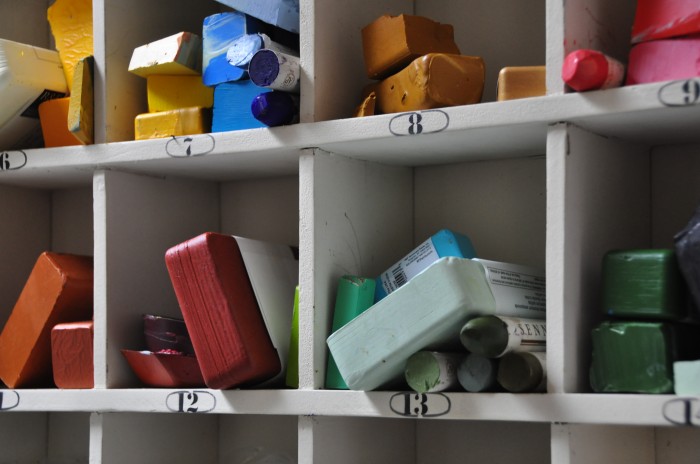
I typically work on a continuum with organic images at one end and geometric shapes at the other. Sometimes I create work that is serialized, based on the repetition of shapes and measurement of the intervals between them. At other times, I improvise along the line of indeterminacy-composer John Cage’s principle of random, unfixed occurrences.
I began working on the series (r)evolution in December 2013, after I was invited to serve as the 2014 Visual Artist for the Music at Menlo Chamber Music Festival and Institute in Atherton, California. Images from my older series, Revolution, were selected to appear on the cover of the concert booklet, the preview flyer and a poster; and an invitation was extended for an exhibition. Intrigued, yet feeling somewhat stymied by the directors’ choice of my older series, I began to consider different possibilities involving the circular images that appear in Revolution.

Revolution 34, encaustic and monoprint on 3 panels, 15×45, 2008
Five paintings later (see images in the previous blog), I felt the need to shake up and loosen my approach. I turned to my hot box and began moving around hot pigmented wax in a delightfully freeing, satisfying way. The results of this experiment proved to be somewhat unpredictable-exactly what I was craving! I discovered I had created two bodies of work: one serialized, using repetitive shapes and rhythms; the other, indeterminate using organic and gestural forms loosely based on circular shapes. Next, I wanted to integrate the two bodies of work. Even though the shapes were more amorphous, I knew it would be possible to weave the circular shapes into this new framework.
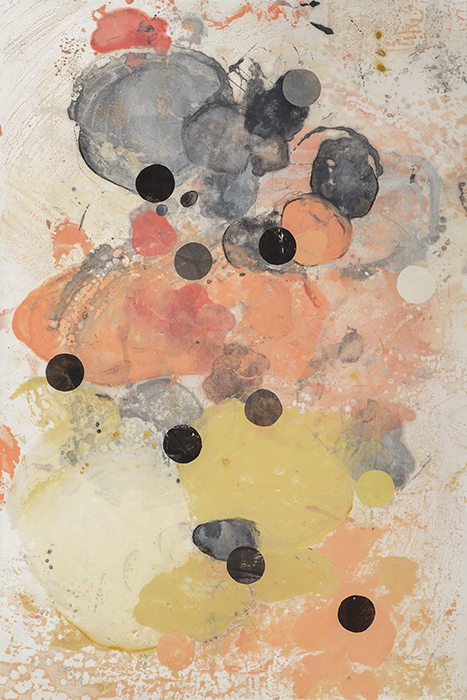
Benthic Revolution 3, encaustic on Mitsumata, 40×26, 2014

Benthic Revolution 2, encaustic on Mitsumata, 40×26, 2014

Benthic Revolution 1, encaustic on Mitsumata, 40×26, 2014
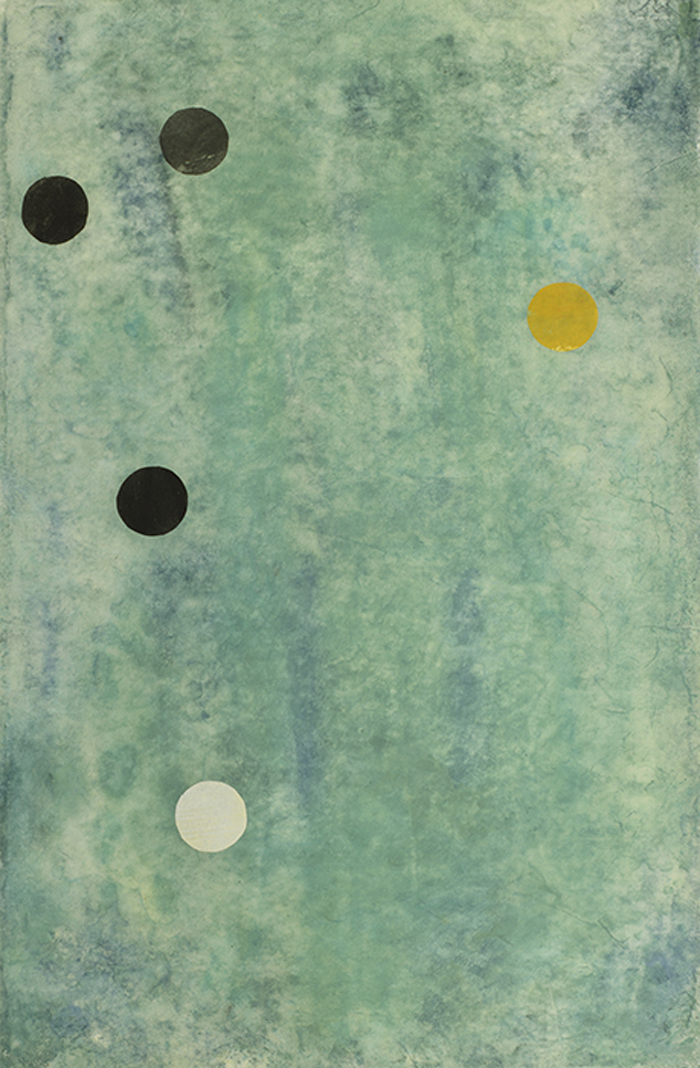
Benthic Revolution 6, encaustic on Mitsumata, 32×21, 2014
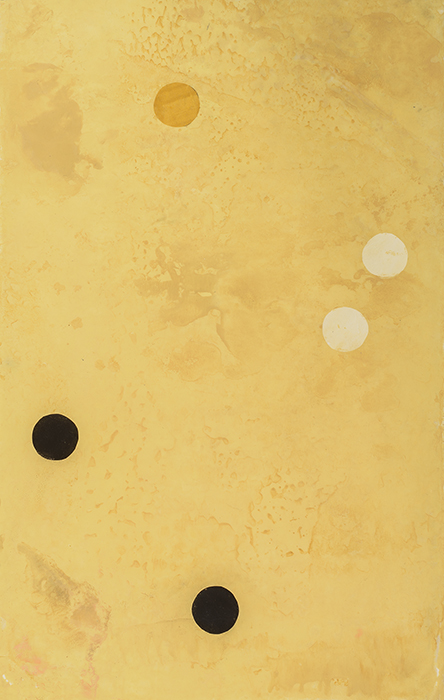
Benthic Revolution 4, encaustic on Mitsumata, 32×21, 2014
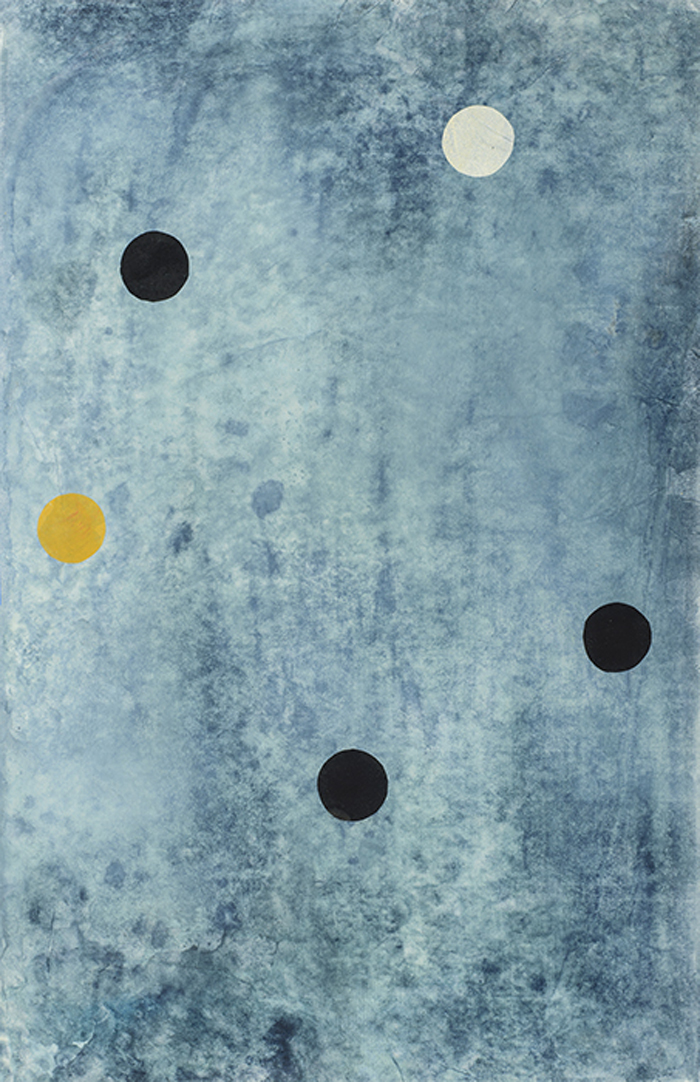
Benthic Revolution 5, encaustic on Mitsumata, 32×21, 2014
As in my previous work, these pieces are built on a grid. Sometimes my grids are explicit, while at other times they are implicit. My current work uses circles on a random and less obvious grid, creating an ambiguity between figure and ground. These are my first attempts at experimenting with possible outcomes from integrating the serial and indeterminate, and geometric with organic.
by Tracey Adams | Mar 18, 2014 | Blog
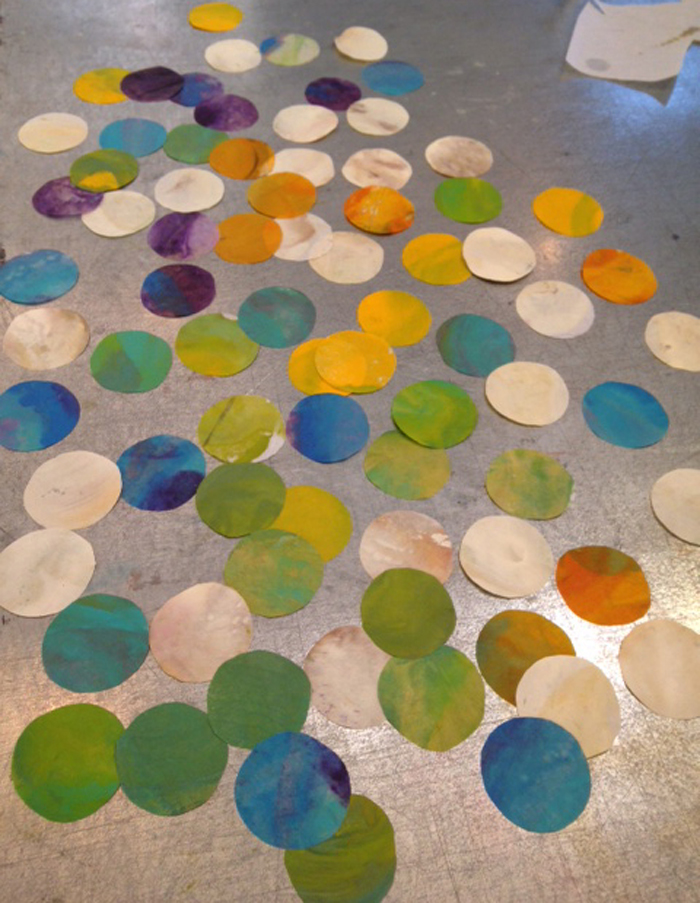
Last October, I was invited to be the 2014 Visual Artist for the Music at Menlo Chamber Music Festival and Institute, a three week event occurring this summer in Atherton, California. It’s is a very exciting time for me, given that music and art are two of the most important things in my life. The founding directors of Music at Menlo, David Finckel and Wu Han, also members of the Emerson String Quartet, chose my Revolution series (2005-2008) to represent this year’s promotional materials and to be exhibited during the event. After experimenting with different ideas, I decided to revisit this series to see what creative possibilities still exist. It is still in the early stages, but four paintings have been completed and three more are underway.

(r)evolution 1, encaustic, collage and oil on panel, 40×40, 2014

(r)evolution 2, encaustic, collage and oil on panel, 40×40, 2014

(r)evolution 3, encaustic, collage and oil on panel, 40×40, 2014
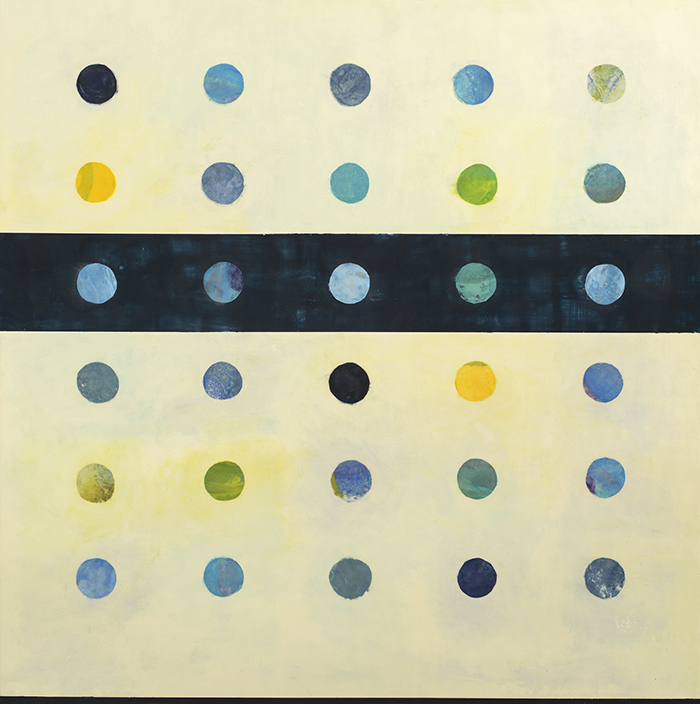
(r)evolution 4, encaustic, collage, oil on panel, 36×36, 2014
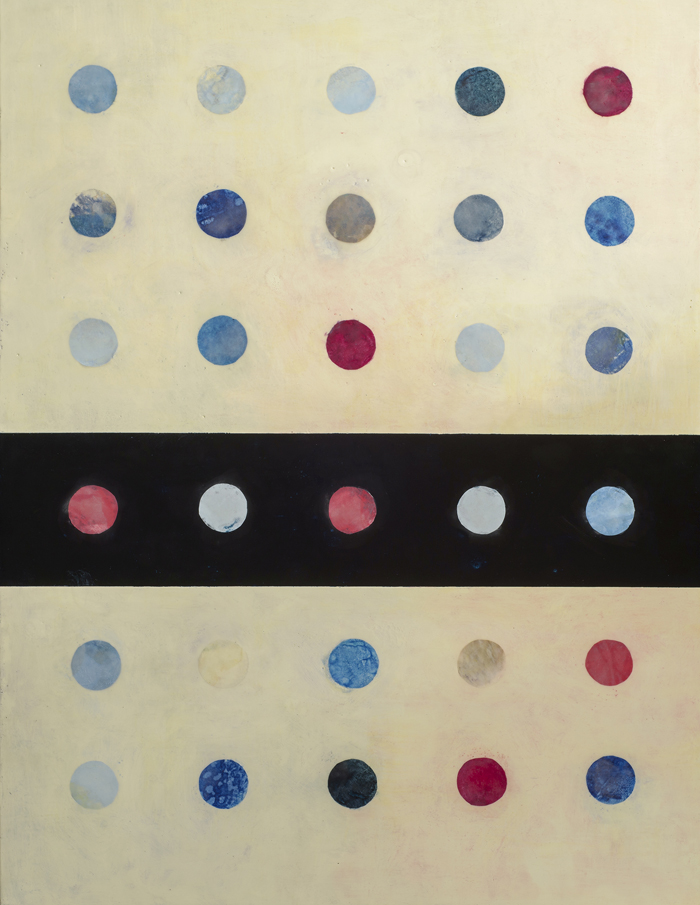
(r)evolution 5, encaustic, collage, and oil on panel, 40×30, 2014
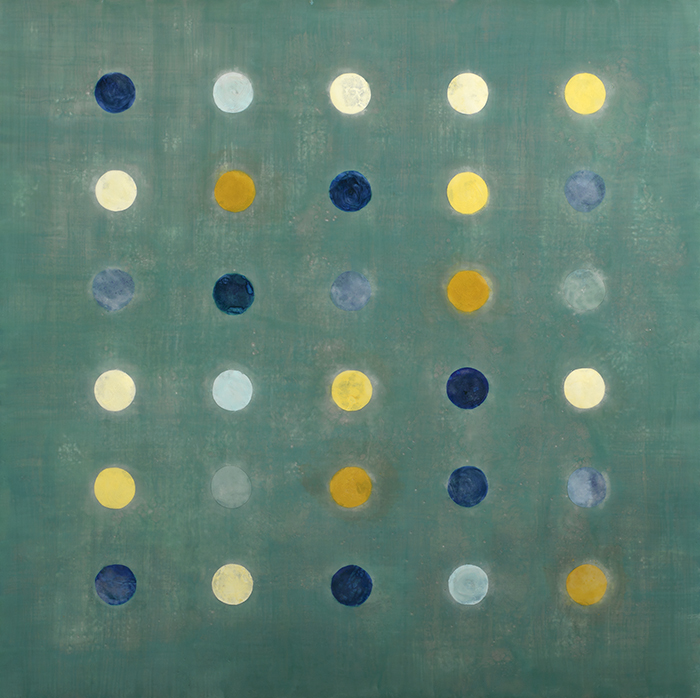
(r)evolution 6, encaustic, collage and oil on panel, 36×36, 2014
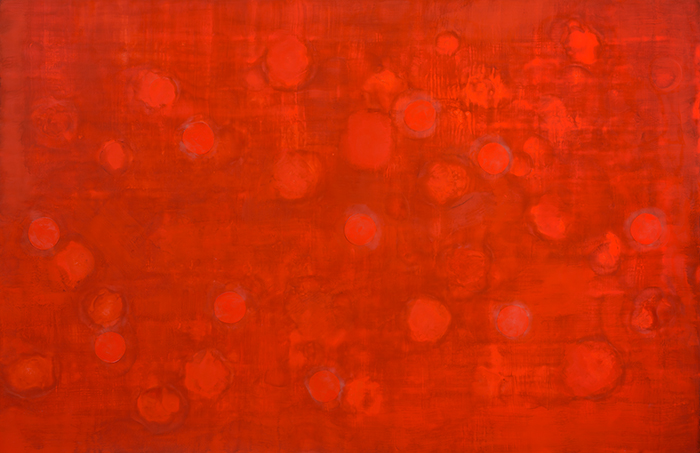
(r)evolution 7, encaustic, collage and oil on panel, 30×40, 2014
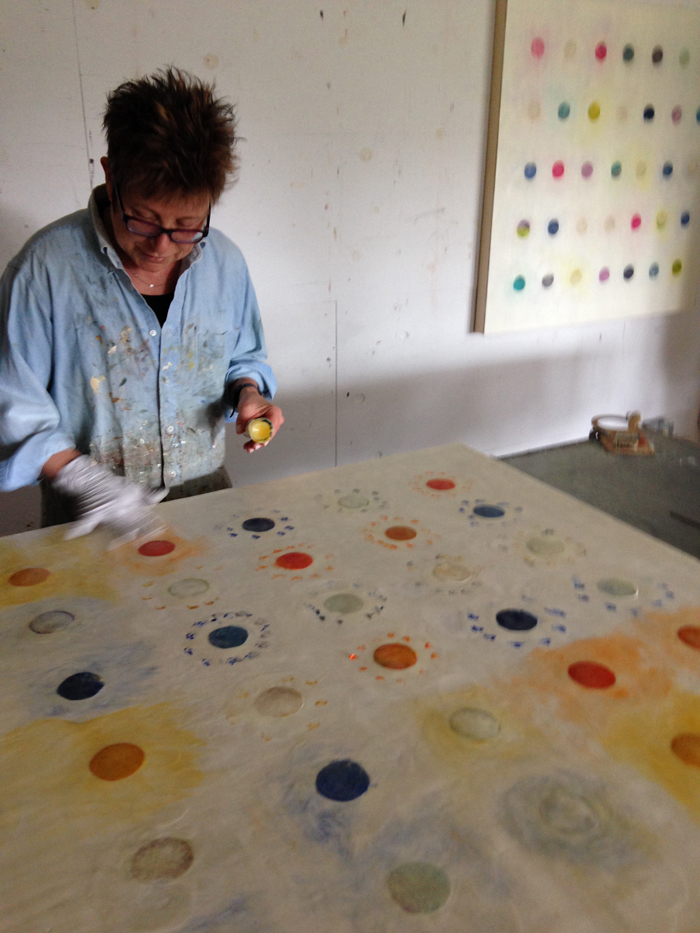
Artist Statement: When printmaking and painting, I work in series by creating an initial motif and then exploring permutations of the theme using color, pattern, line and shape. Influenced and inspired by my study of music theory, I am drawn to the intersections of music, art and math. My process includes repeating patterns, using mathematical calculations and developing serial systems based on geometric structures such as the grid. Each series I create has a natural evolution and connection to the next resulting in a synthesis of intention and chance. I work with a variety of media choosing the materials that communicate my ideas best; my recent pieces are created using encaustic, oil, acrylic, graphite, ink and collaged prints.
by Tracey Adams | Dec 30, 2013 | Blog
Geoform (www.geoform.net) is an online scholarly resource and curatorial project, founded by Julie Karabenick almost 10 years ago. Its focus is on the use of geometric form and structure in contemporary abstract art. Artists included in this project number 260 and are from approximately 25 different countries. It is a monumental and amazing collection of some of the finest geometric art around.
The scope of work included in Geoform includes works on paper, works on canvas and panel, and sculpture utilizing traditional media to repurposed and recycled materials. These artists are inspired by nature, spirituality, music, poetry, mathematics as well as formal aspects of art like color and shape. The variety of formal structures used to organize these extraordinary works includes grids, optical illusions and universally recognized shapes like circles, dots, squares, rectangles, triangles and bands of color. Some work is reductive and minimal, other patterned and repetitive.
It was very difficult to limit my choice of work to only 20 artists, my self-imposed number, but I wanted to introduce the work of some unfamiliar artists as well as groundbreakers in the field of geometric art. My sincere apologies to all the wonderful work of colleagues whose work was not included.
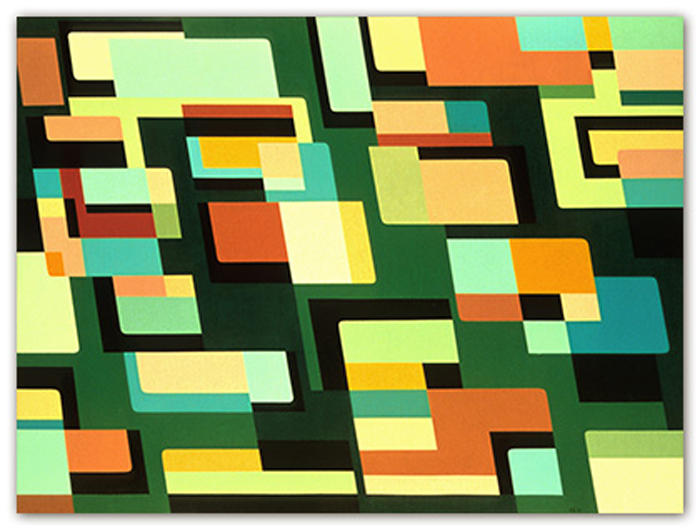
Karl Benjamin, Red, Yellow, Green, oil on canvas, 1957
“Color in the hands of a painter resists verbal definition because it has nothing to do with words, nor with theories nor with physics of light. Color is the subject matter of painting.”
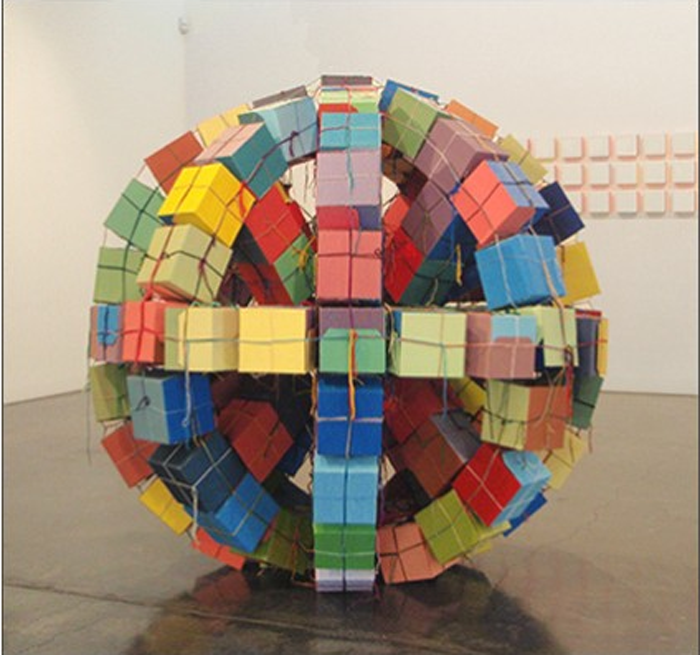
Kate Mackay, Large Round Cube, acrylic on cardboard with yarn, 2011
“The work has become progressively concerned with process and random difference within uniformity. Series of works are created by repeated combinations of simple elements concentrating on the repetition of blocks, squares and circles.”
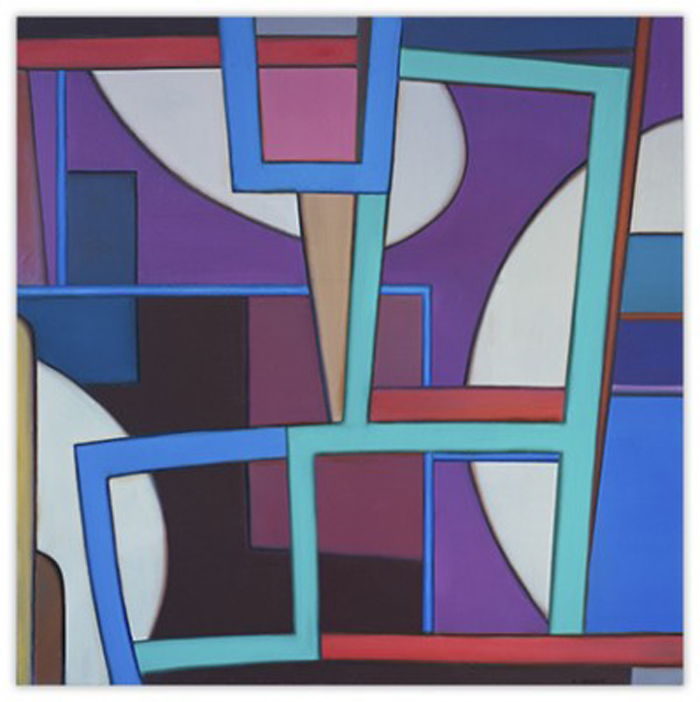
William Conger, Red Summer, oil on canvas, 2012
“I want my paintings to be metaphorical in the sense that although they depict nothing abstracted, they are ‘as-if’ alternatives to our experiences in the world.”
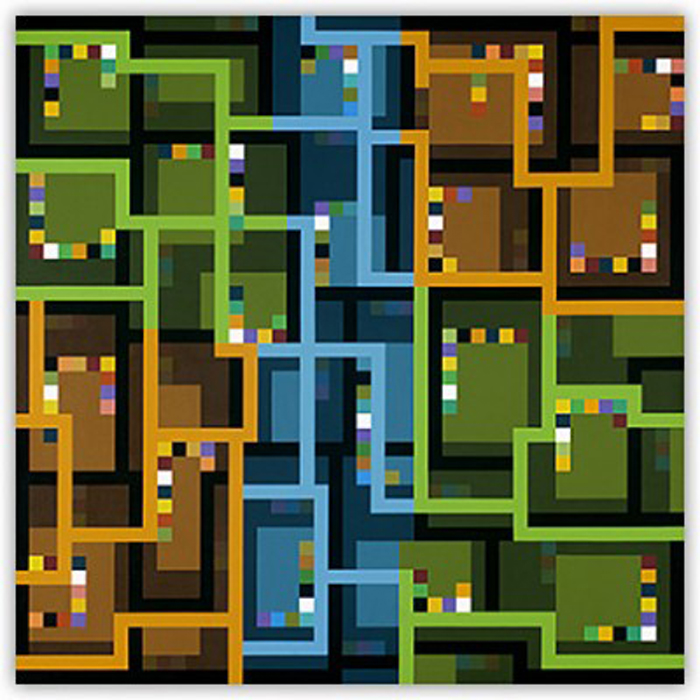
Julie Karabenick, Composition 109, acrylic on canvas, 2010
“In the paintings from my ongoing series Composition Series, I limit myself to a few geometric shapes – to squares and rectangles of flat, uninfected color. From the stability and symmetry of the grid, I develop compositions that are to some degree asymmetrical and dynamically balanced.”
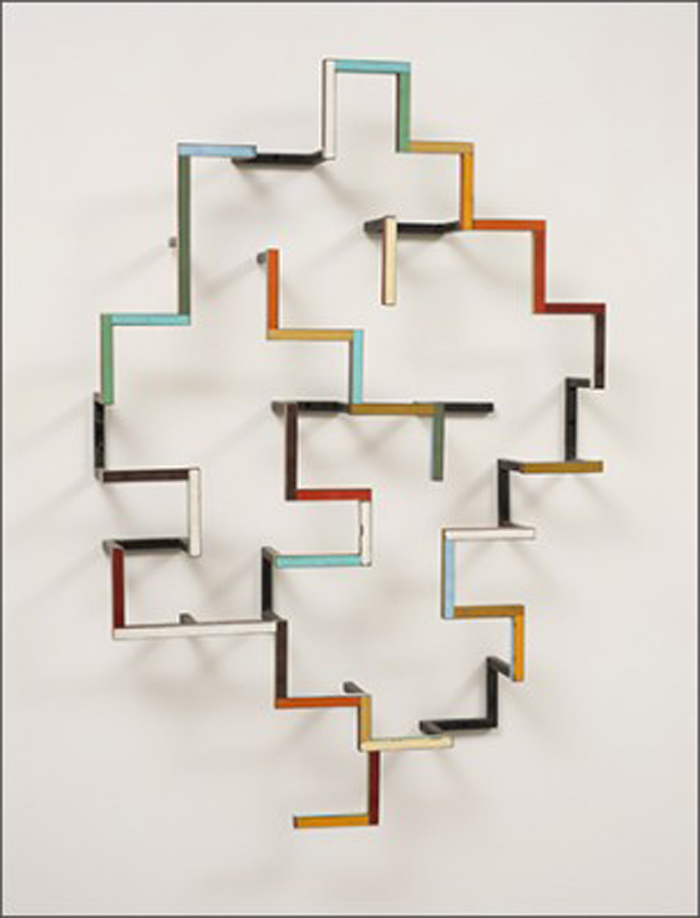
Ted Larsen, Loose Knot, salvage steel, welded steel, silicone, hardware, 2013
“I am constructing assemblages of deitrus in order to repurpose the materials and re-identify their meanings: to re-contextualize and re-label the idea of readymades.”
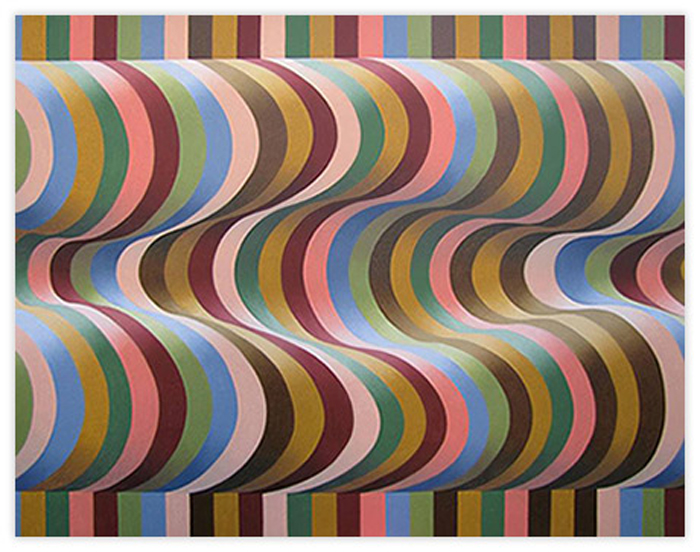
Yuli Geszti, Suite for 7 Colors to Celebrate the Overthrown Centenary Tree, acrylic on canvas, 2013
“My work is motivated by a challenge: to create the illusion of three-dimensional volumes on the flat surface of the canvas, using only brushes and ink.”
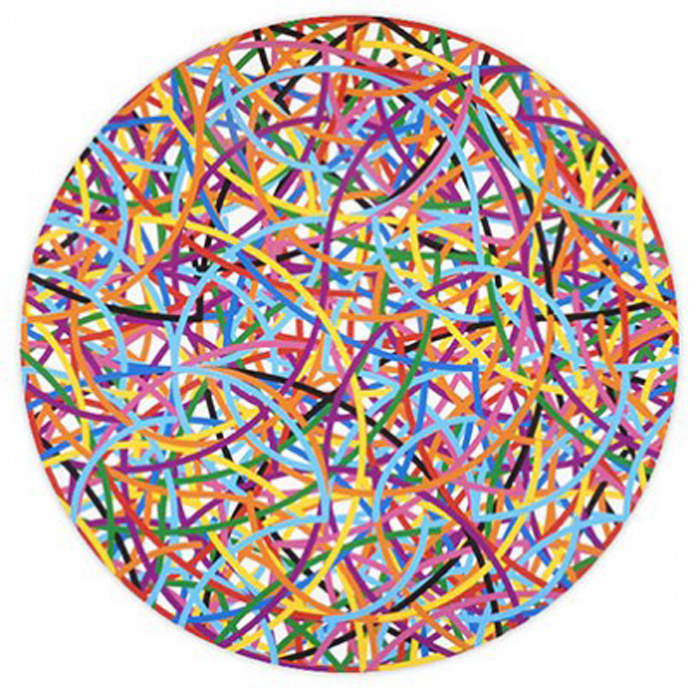
Per Formo, Ganymede 1, digital print on paper mounted on aluminum, 2012
“I want to make the act of looking into a conscious effort both to actually see what you’re looking at, and, at the same time, to observe the act of seeing: what you do when you see, how you are working at constructing visual meaning.”
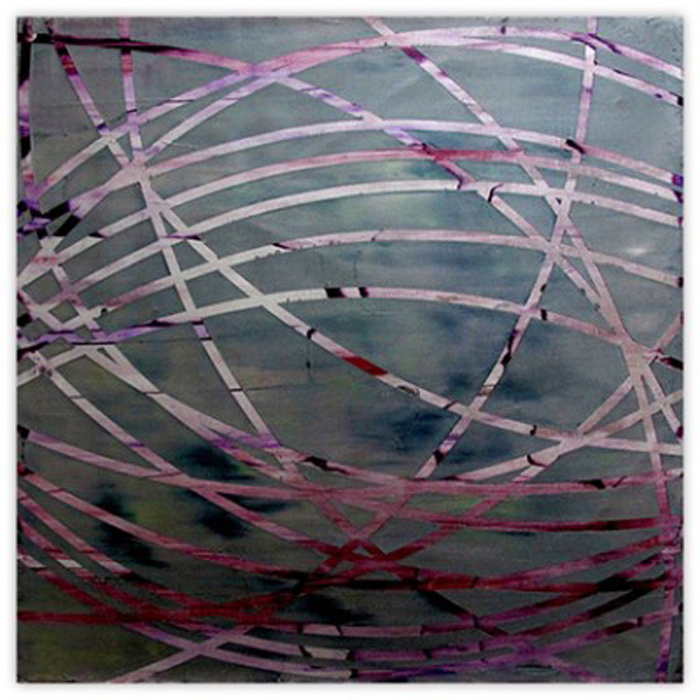
Gudrun Mertes-Frady, Nest #20, oil and metallic pigments on canvas, 2013
“Architecture and geometry have always been present in my work; even in the earlier works, the underlying matrix was the grid.”
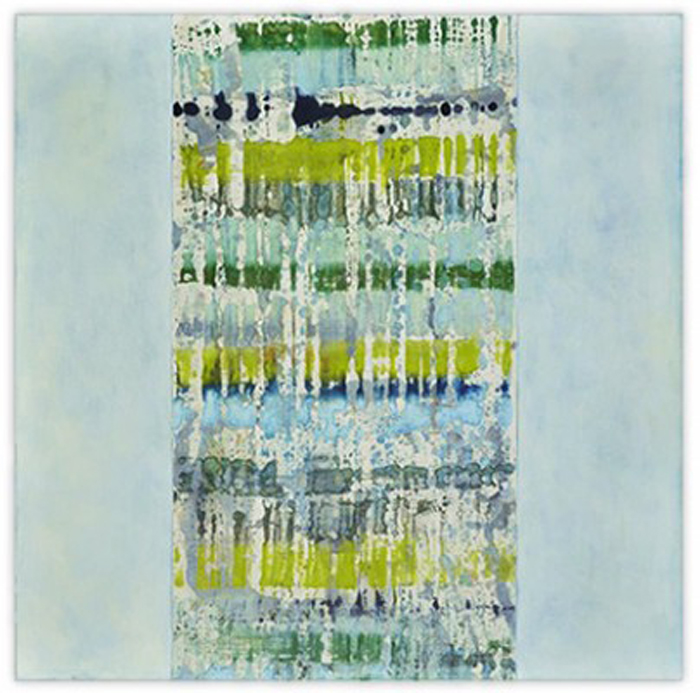
Tracey Adams, Radix 22, encaustic monotype, acrylic, oil glazes on panel, 2012
“I consistently have been drawn to forms that are sympathetic to structure, yet open to improvisation. Recent investigations into the mathematical expression of the proportional ratio found in nature, known as the Golden Section, have had an influence on my work”.
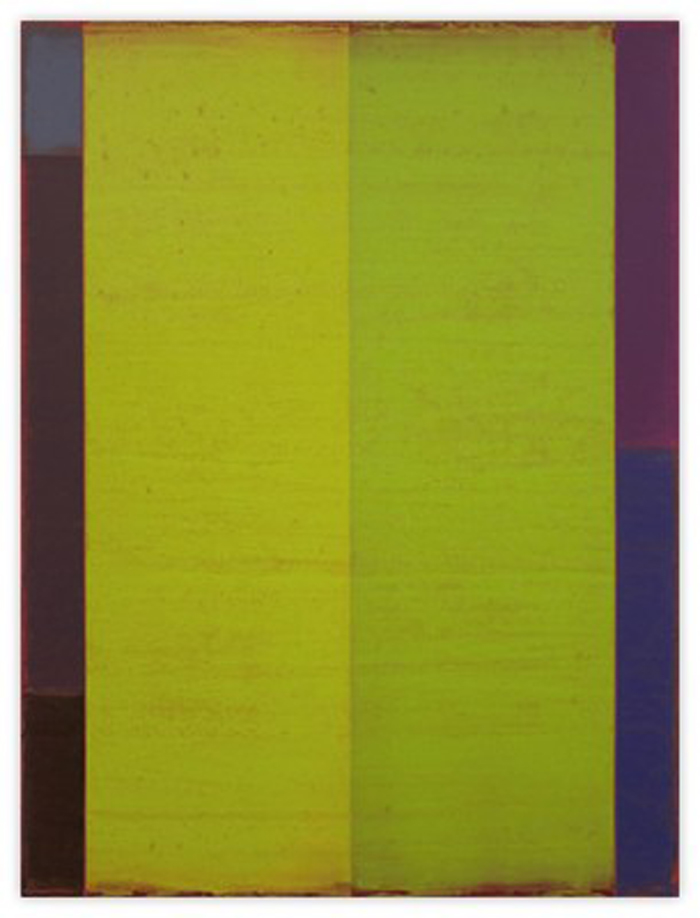
Steven Alexander, Palm (2), acrylic on canvas, 2013
“I am interested in the interaction between the painting and the viewer’s imagination, and in the painting’s potential to generate unspecified mobile meaning. Color operates in the world as a kind of pure energy – dynamic, capricious, evocative.”
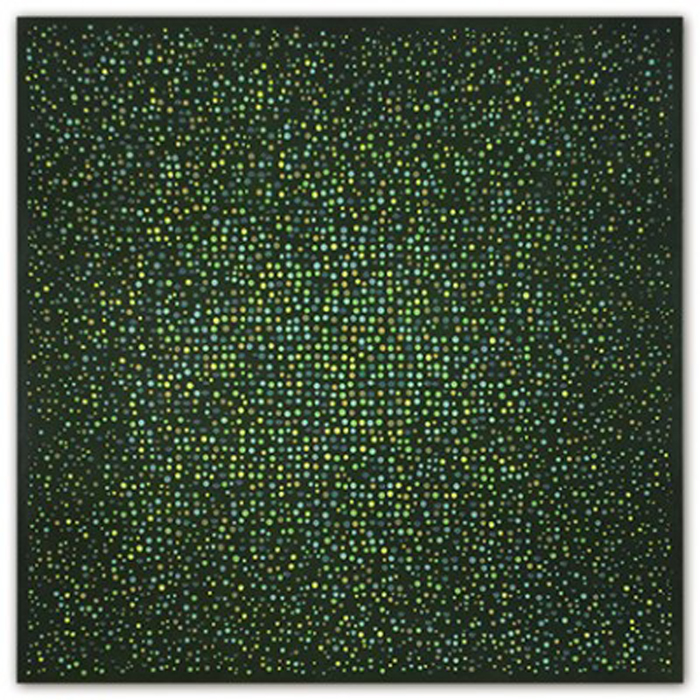
Reese Inman, Migration II, acrylic on panel, 2011
“Each painting represents dialogue between a specific computer algorithm and my hand”
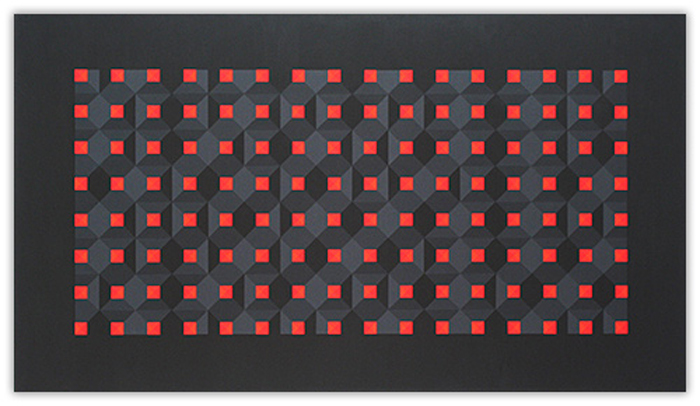
Gerhard Hotter, Pyramids XXXI, acrylic on canvas, 2013
“For more than 30 years I have been researching the pictorial and poetic potentials of mathematical structures. It’s the more playful part of mathematics-mathematics for its own sake – that attracts me.”
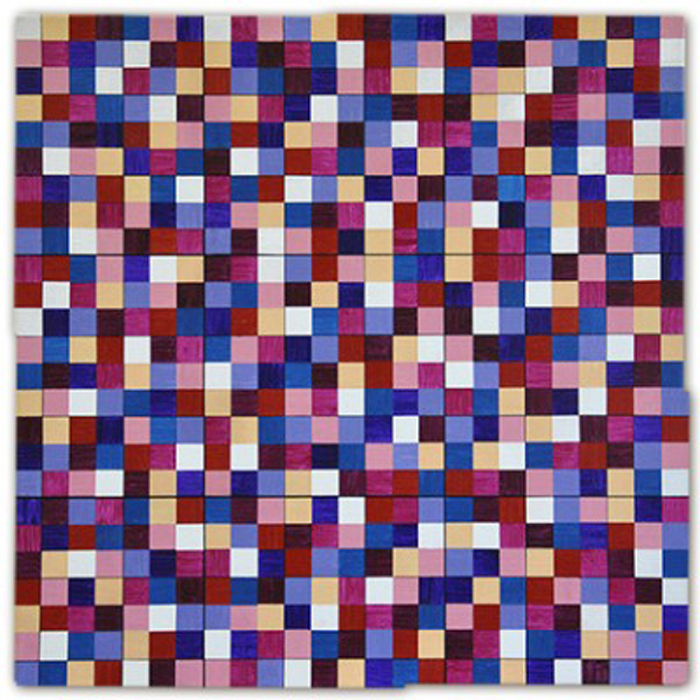
Herman Van de Poll, geoChao 145, acrylic and oil on linen, 2012
“My art has been influenced by modern scientific and mathematical approaches to understanding the complex order in nature.”
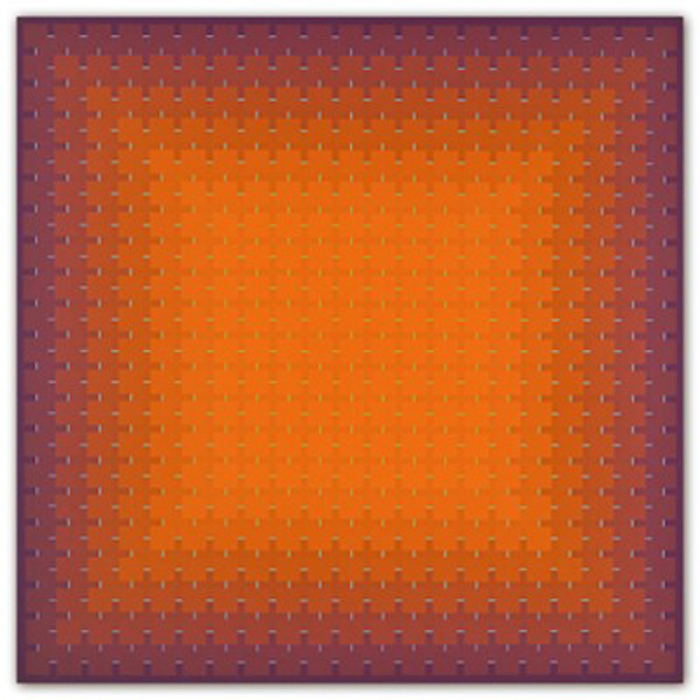
Julian Stanczak, Lumina, Offering Orange, acrylic on canvas, 1991
“My primary interest is color, the energy of the different wavelengths and their juxtapositions.”

Richard Kallweit, Triacontahedron Sphere, paper with offset printing, 2011
“I use various ideas culled from math and science to create paintings and sculptures. They are related in part to weaving technologies, which have been called the earliest higher mathematical discoveries of man.”
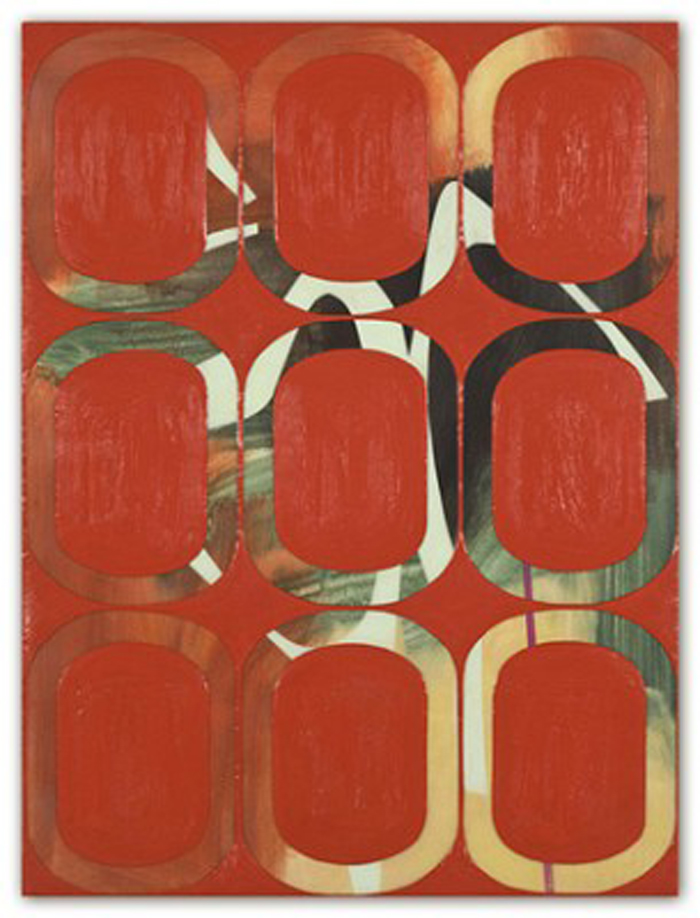
Amy Ellingson, Inverse Study #2, oil and encaustic on panel, 2010
“My interests lie in the practice of formal repetition, variation and mutation within limited serial systems and networks. The paintings consist of many interrelated layers of repeating geometric forms-lines, arcs and grids-that I compose on the computer.”
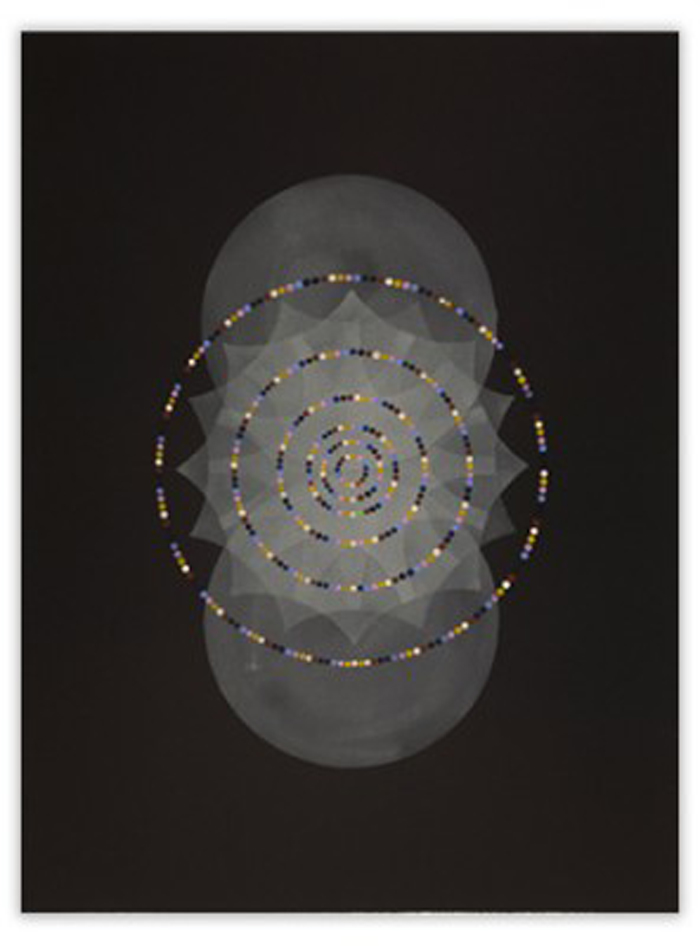
Grace DeGennaro, Ballinglen #21, watercolor on Somerset paper, 2013
“I am interested in the power of traditional symbols and sacred geometry to communicate ideas that lie beyond the limitations of language and culture.”
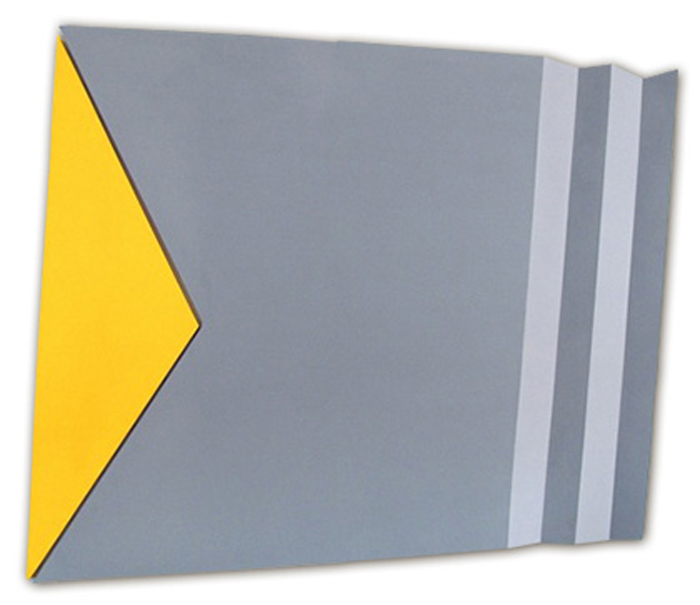
Raphael Durans, Pliage No. 116 (diptych), acrylic on canvas, 2011
“What interests me about all is proportion-what I call intuitive proportion. Using irregularly shaped canvases, I examine space beyond the square or rectangle.”
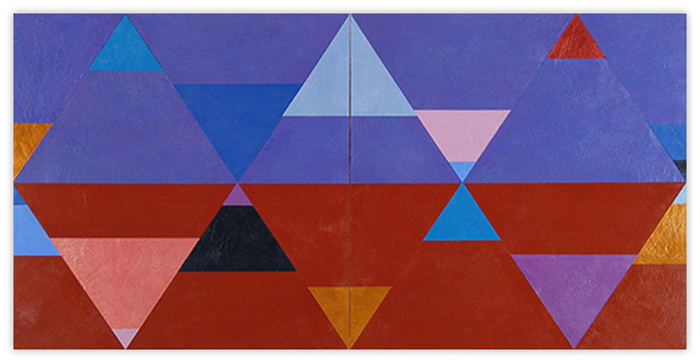
Joanne Mattera, Chromatic Geometry 13, encaustic on panel. 2013
“My paintings are succulent in color and reductive or repetitive in composition. I usually refer to my esthetic as “lush minimalism.”
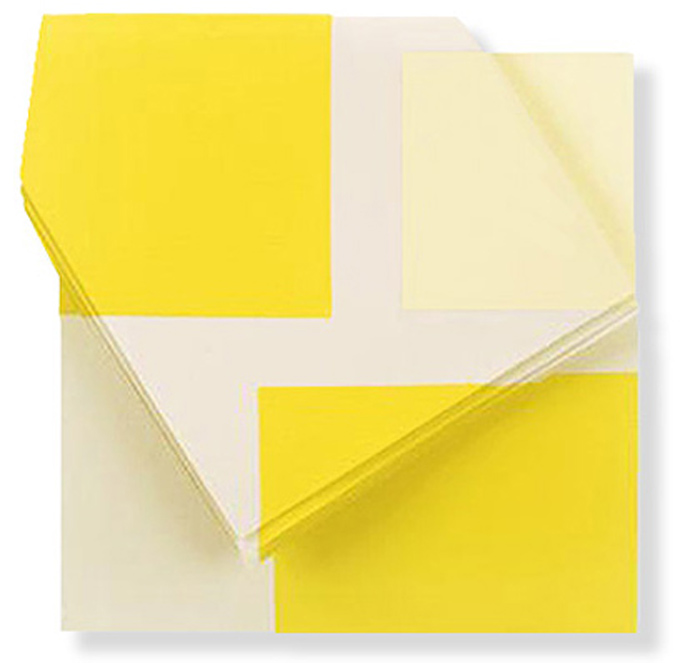
Luciano Figueiredo, Relief #2, acrylic on canvas, 2009
“Throughout my years of making art, all of my research with basic formal elements such as color, volume, space and light has had a strong relationship with the other arts such as poetry, film, music and graphics as well.”
All images are courtesy of www.geoform.net. I invite you to visit the website and explore further the wealth and variety of geometric art and fascinating artist interviews that Julie has curated.
by Tracey Adams | Dec 2, 2013 | Blog
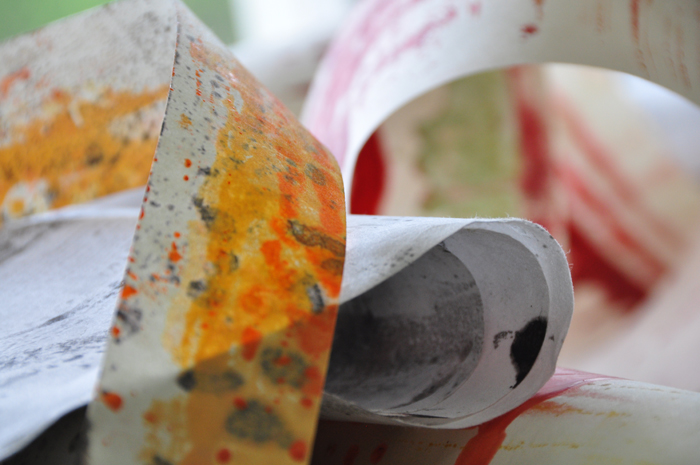
Elaine de Kooning said it so well, “Collage is a marriage of accident and intention.” Collage is one of the most soul-satisfying studio practices I do at any time, any place and with any materials on hand. It functions like a journal posting in that I don’t often share it with others. It reflects my state-of-mind on a given day in that it can be dark, whimsical/fun, or meditative. It can be geometric, organic or a combination of both. It can be bright and colorful or monochromatic. While I never have an idea of where I’m going or what a collage will look like when finished, it is precisely that aspect that provides the necessary component of intrigue to keep me engaged. Sometimes, collage has sparked a new direction in my work so I try to let it have a life of its own. I love looking at other artists’ collages and assume that those of us who share this love of medium do it for similar reasons. Some collages are politically and narratively driven, some are playful and personal, and some have more formal intentions. Below is a group of some of my favorite collage artists.
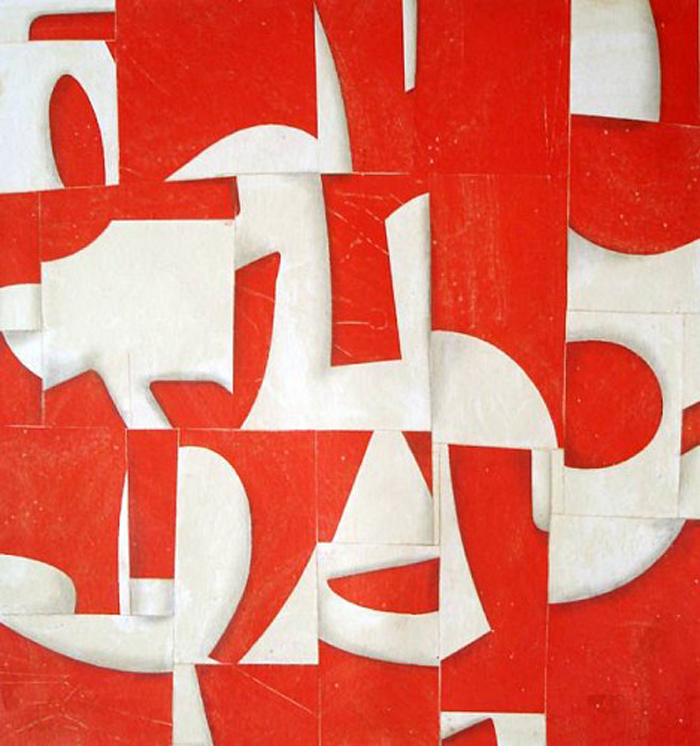
Cecil Touchan, Untitled, www.searspeyton.com
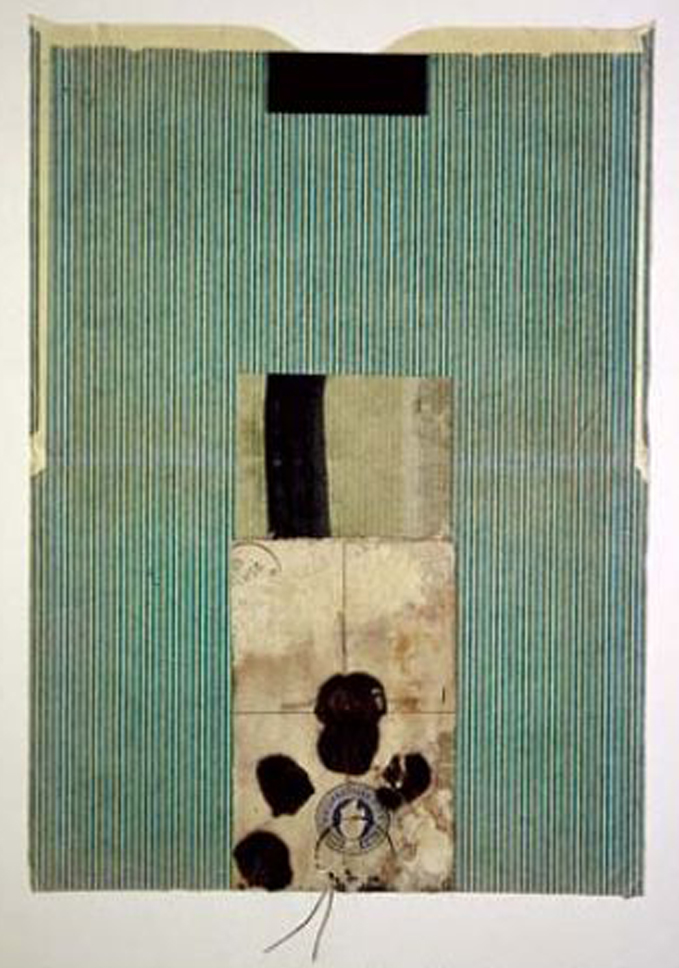
Dennis Parlante, Stability, www.dennisparlante.com
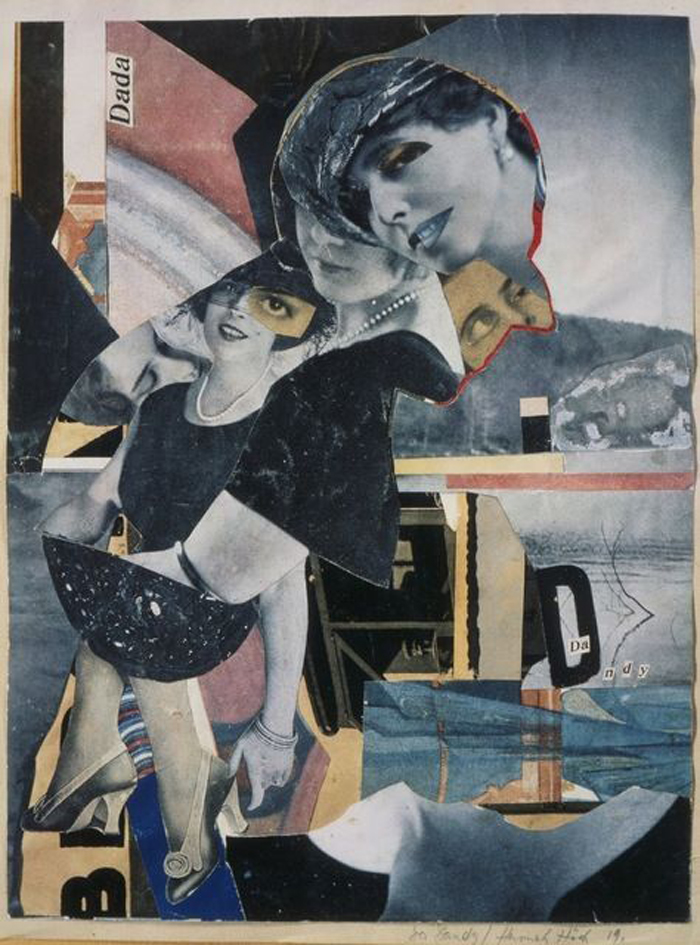
Hannah Hoch, Untitled, www.artsy.net
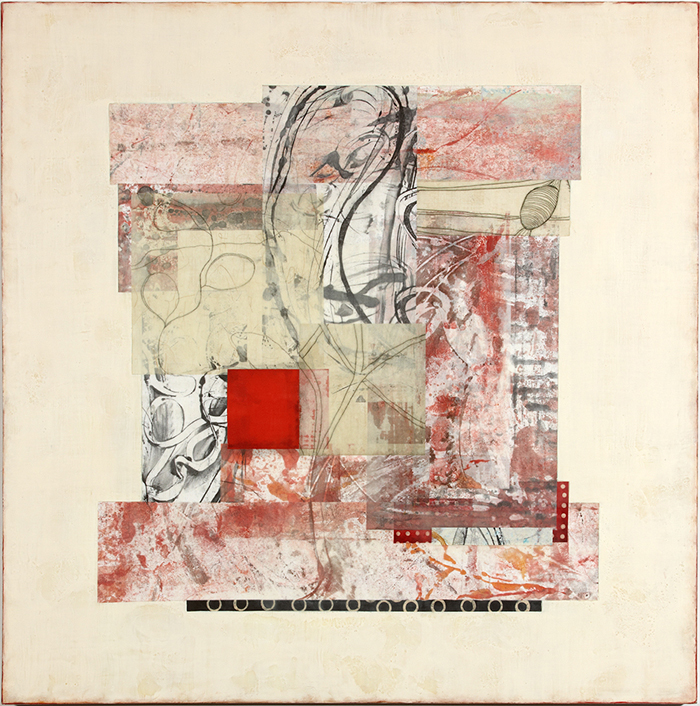
Tracey Adams, Radicle 14, www.montereyart.org

Kim Frohsin, Coke, Popcorn, Circus, Diamond, www.bryantstreet.com
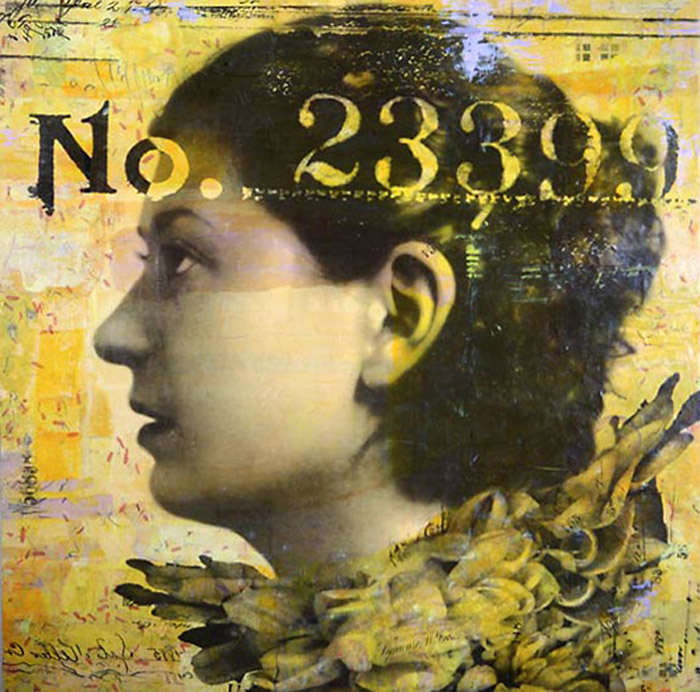
Marybeth Rothman, Amelia, www.marybethrothman.com
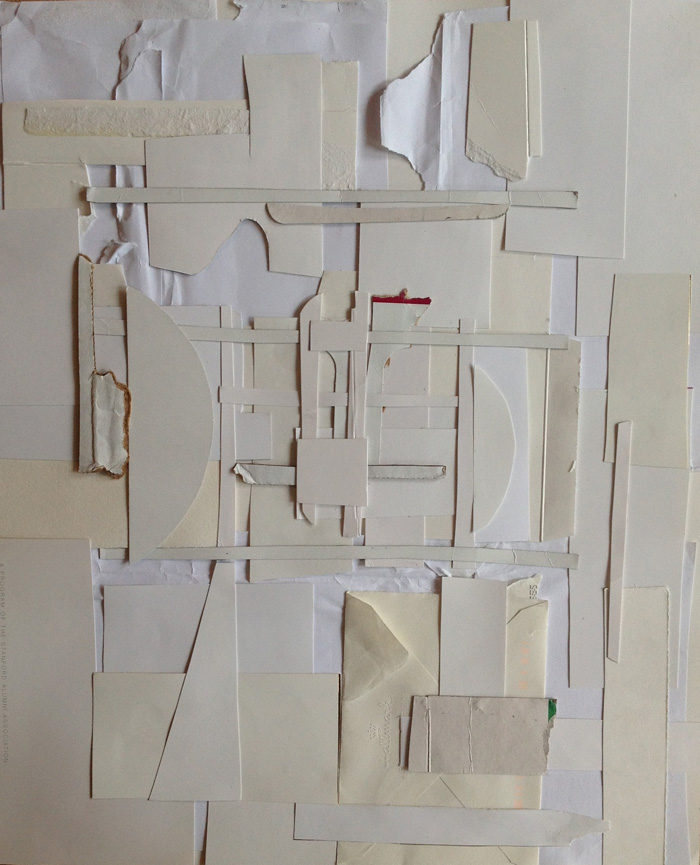
Matt Gonzalez, White 1, www.sfcollagecollective.wordpress.com
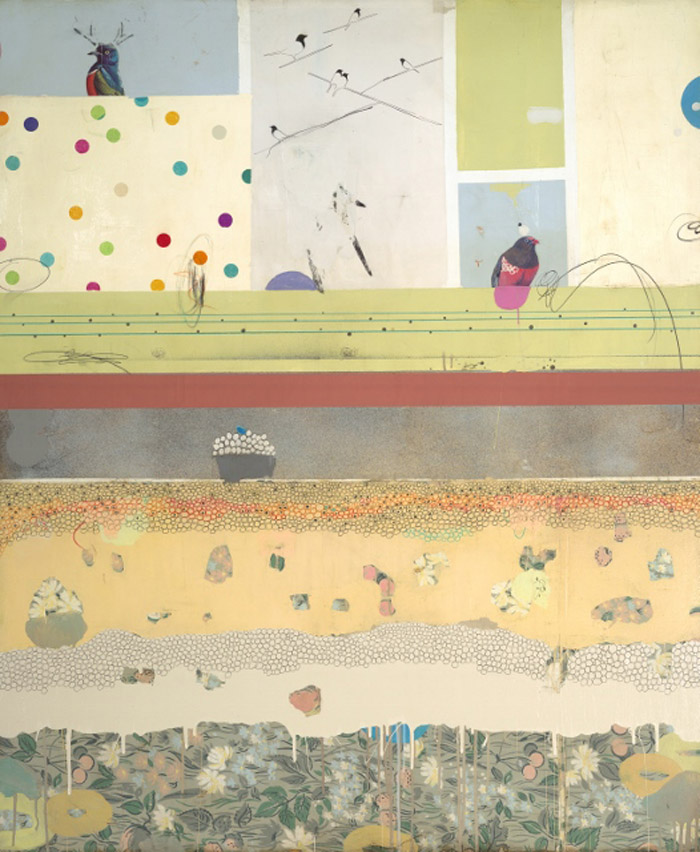
Michael Cutlip, Bird-on-a-Wire, www.michaelcutlip.com
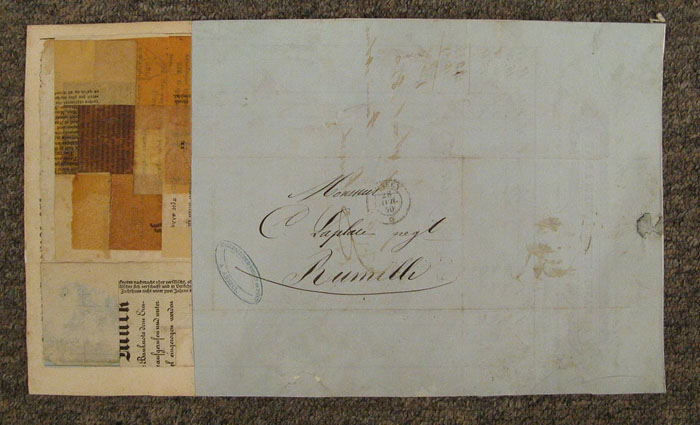
Michael Pauker, www.michaelpaukerblogspot.com
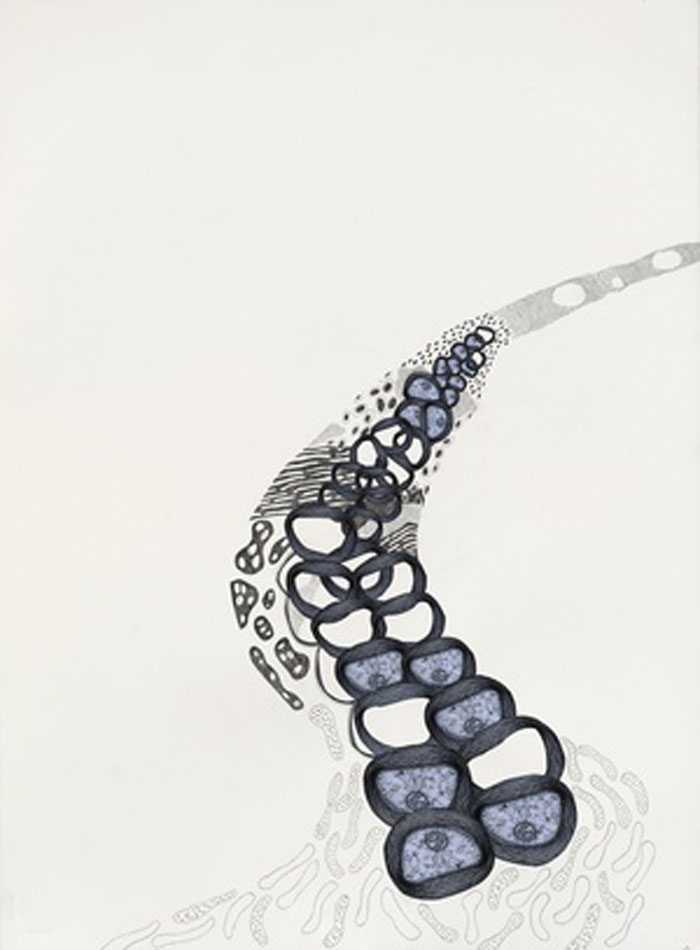
Kirsten Stolle, Genetic Erosion, www.kirstenstolle.com
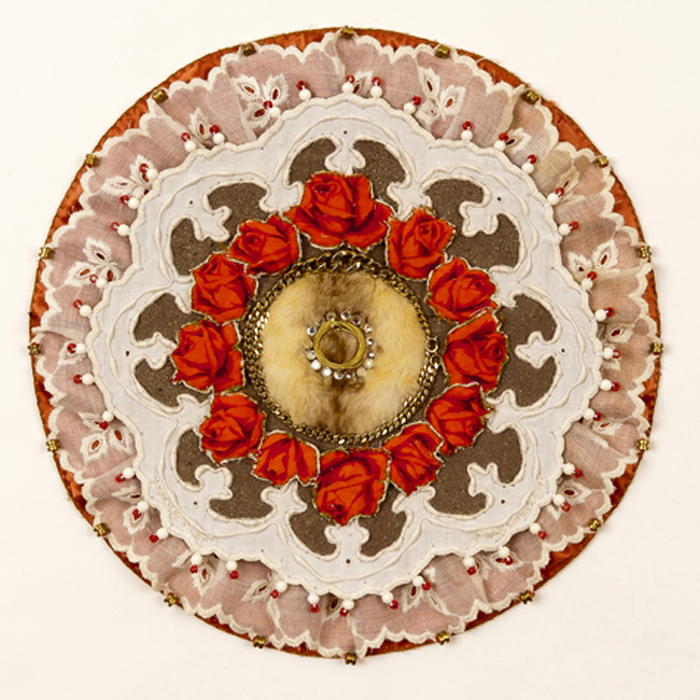
Donna Sharrett, Magnificent, www.pavelzoubok.com
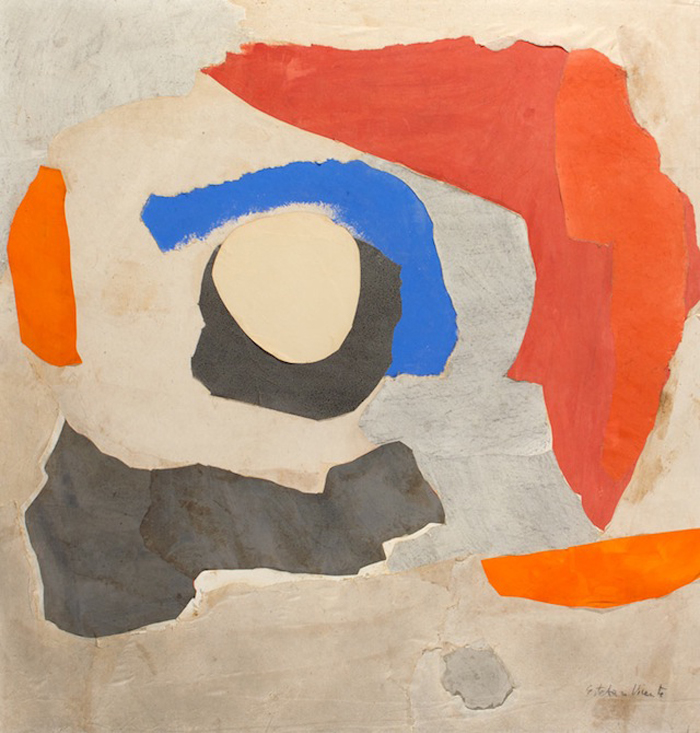
Esteban Vicente, Hawaii, www.hyperallergic.com
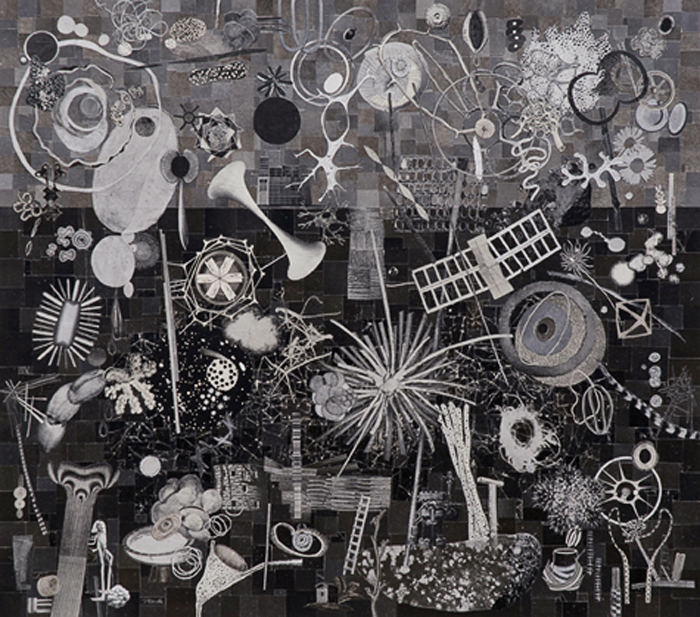
Maritta Tapanainen, Frontera, www.pavelzoubok.com


































































